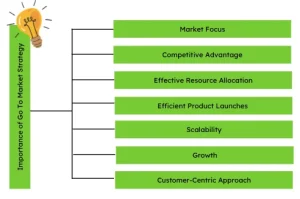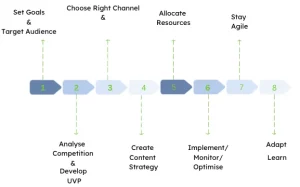A Comprehensive Guide to Build A Go to Market Strategy
A go to market strategy is a plan that outlines how a company will bring its product or service to market, including the target audience, distribution channels, marketing tactics, and sales approach. It encompasses the steps and activities required to launch and sell a product or service to customers.
“Without a well-executed go-to-market strategy, even the most innovative product or service will remain hidden in the shadows.”-Anonymous
Having a product or service does not suffice unless you know how to reach your audience. If you are interested in getting a go to market strategy, it is important that you understand the dynamics first.
Let us dive deep into what is strategy marketing and how you can develop one for your brand.
What is the Go to Market Strategy (GTM)?
The go-to-market (GTM) strategy is a comprehensive plan that outlines how a company will introduce and sell its products or services to customers. It encompasses various aspects such as target market identification, marketing and advertising strategies, distribution channels, pricing, sales tactics, and customer support.

The GTM strategy aims to maximise market penetration, create brand awareness, drive customer acquisition, and generate revenue.
Features of GTM strategy
The features of a go-to-market (GTM) strategy include:
- Market Analysis: Conduct thorough research to understand the target market, customer needs, and competitive landscape.
- Product Positioning: Determining how the product or service will be positioned to differentiate it from competitors.
- Pricing Strategy: Develop a pricing model that aligns with the value proposition and target market while considering profitability.
- Distribution Channels: Identifying the most effective channels to reach and distribute the product or service to the target audience.
- Marketing and Promotion: Creating a comprehensive marketing plan that includes advertising, branding, digital marketing, and promotional activities.
- Sales Approach: Defining the sales strategy, including sales team structure, training, and customer engagement tactics.
- Customer Support: Establishing a framework for ongoing customer support, including post-sales services, technical assistance, and customer feedback management.
- Metrics and Evaluation: Setting key performance indicators (KPIs) to measure the success of the GTM strategy and regularly evaluating and adapting it based on market dynamics and customer feedback.
Read: What is Strategy Consulting?
Importance of Go To Market Strategy
The importance of a go-to-market (GTM) strategy in marketing is significant for several reasons:

Market Focus:
A GTM strategy helps businesses define and target specific market segments effectively. It ensures that marketing efforts are directed toward the right audience, maximising the chances of success and reducing wasted resources.
Competitive Advantage:
A well-executed GTM strategy enables businesses to differentiate their products or services from competitors. It highlights unique value propositions and positions the offerings in a way that resonates with customers, giving the business a competitive edge.
Effective Resource Allocation:
By outlining the marketing channels, tactics, and budgets, a GTM strategy helps optimise the allocation of resources. It ensures marketing investments are directed towards the most impactful activities, maximising ROI and minimising wastage.
Efficient Product Launches:
A GTM strategy is crucial in product launches. It guides the entire process, from creating awareness to driving sales, resulting in a smoother and more successful product introduction to the market.
Scalability and Growth:
With a GTM strategy, businesses can scale their marketing efforts systematically as they grow. It provides a framework for expanding into new markets, launching new products, and reaching new customer segments.
Customer-Centric Approach:
A GTM strategy emphasises understanding customer needs, preferences, and pain points. By aligning marketing activities with customer insights, businesses can deliver a better customer experience, build strong relationships, and foster loyalty.
A complete guide to marketing strategy development
Here is a comprehensive guide to developing a marketing strategy:

Set clear goals
Start by defining your marketing objectives. These goals should be specific, measurable, achievable, relevant, and time-bound (SMART). They should align with your overall business objectives.
Understand your target audience
Conduct thorough market research to gain insights into your target market. Identify their demographics, behaviours, preferences, and pain points. This information will help you tailor your marketing efforts effectively.
Analyse the competitive landscape
Assess your competitors’ strengths, weaknesses, and strategies. Identify gaps and opportunities in the market that you can leverage. This analysis will guide your positioning and differentiation strategies.
Develop a unique value proposition (UVP)
Define what separates your brand. Craft a compelling UVP that communicates the unique benefits and value you offer to your target audience.
Choose the right marketing channels
Select the most appropriate marketing channels to reach your target audience effectively. This may include digital marketing (social media, content marketing, email marketing, and search engine optimisation) and traditional marketing (print media, television, radio, and outdoor advertising).
Create a content strategy
Develop a content plan that aligns with your marketing goals and resonates with your target audience. Create valuable and engaging content that educates, entertains, or solves their problems. Distribute it through various channels to increase brand awareness and attract potential customers.
Allocate Resources
Determine your marketing budget and allocate resources based on your goals and priorities. Consider factors such as advertising costs, personnel, technology, and any required external agency or vendor support.
Implement, monitor and optimise:
Execute your marketing strategies and closely monitor their performance. Track key metrics such as website traffic, conversion rates, social media engagement, and sales. Use data-driven insights to optimise your strategies and make informed decisions.
Stay agile and adapt
Monitor market trends, consumer behaviour, and industry dynamics continuously. Be prepared to adapt your marketing strategy to stay ahead of the competition and meet changing customer needs.
Evaluate and learn
Regularly evaluate the effectiveness of your marketing efforts against your goals. Analyse the results, identify successes and areas for improvement, and apply these learnings to refine your future marketing strategies.
Marketing Strategy Examples
Here are a few examples of go-to-market (GTM) strategies employed by businesses:
Direct Sales:
This strategy involves selling products or services directly to customers without intermediaries. It often includes a sales team that engages with potential customers through cold calling, networking, and personalised demonstrations.
One brand example that utilises a direct sales go-to-market (GTM) strategy is Cutco, a manufacturer of high-quality kitchen cutlery and accessories. Cutco employs a direct sales model by engaging a network of sales representatives known as “Cutco Consultants.”

The company trains these consultants and directly sells Cutco’s products to consumers through in-home product demonstrations. They reach out to potential customers, schedule appointments, and showcase the product’s features and benefits firsthand. The consultants build customer relationships, provide personalised recommendations, and handle the entire sales process, including order placement and after-sales support.
This strategy enables Cutco to establish a direct connection with customers, build trust, and highlight the value of their products, resulting in higher customer satisfaction and repeat purchases.
By leveraging a direct sales GTM strategy, Cutco effectively bypasses intermediaries and controls the entire sales process. They can maintain a strong brand presence, gather valuable customer feedback, and deliver exceptional customer service, all while directly influencing the customer’s buying decision.
Channel Partnerships:
Businesses form strategic alliances with channel partners such as distributors, resellers, or retailers to reach a broader customer base. This strategy leverages the partner’s existing network and expertise to distribute and sell the products.
An example of a brand that employs a channel partnership go-to-market (GTM) strategy is Cisco Systems. Cisco works with a network of channel partners, including value-added resellers (VARs), system integrators, and distributors, to distribute and sell its networking and communication products.
These channel partners play a crucial role in reaching customers in various industries and geographies.

Cisco provides its partners with training, certification programs, and marketing support to ensure they have the expertise to effectively promote and implement its solutions. Through this channel partnership GTM strategy, Cisco leverages the partner’s salesforce, distribution channels, and industry knowledge to expand its market reach and deliver comprehensive networking solutions to customers worldwide.
Online Sales and E-commerce:
Companies establish a strong online presence through websites, online marketplaces, or e-commerce platforms. They utilise digital marketing techniques, search engine optimization (SEO), and online advertising to drive traffic and generate sales.
Amazon’s GTM strategy revolves around its robust online platform, selling many products to consumers worldwide. The company focuses on offering a seamless and convenient shopping experience through features like one-click purchasing, personalised recommendations, and fast delivery options.

Amazon leverages its vast product selection, competitive pricing, and customer reviews to attract and retain customers. Additionally, Amazon employs various marketing techniques, such as targeted online advertisements, email campaigns, and affiliate programs, to drive traffic to its platform and promote its products.
Through its e-commerce GTM strategy, Amazon has become a dominant player in the online retail industry, constantly expanding its product offerings and enhancing its customer experience.
Freemium Model:
This strategy involves offering a basic version of the product or service for free while charging for premium features or additional functionalities. It allows businesses to attract a large user base, create brand awareness, and convert free users into paying customers.
A brand that implements a freemium model go-to-market (GTM) strategy is Spotify. Spotify offers a free version of its music streaming service with limited features and advertisements while providing a premium subscription option for enhanced features and an ad-free experience.

The freemium model allows Spotify to attract a large user base by offering free access to its platform, which serves as a marketing tool to showcase the value and convenience of its service. Spotify leverages this user base to generate revenue through targeted advertising and converts some of its free users into paying premium subscribers.
This GTM strategy enables Spotify to reach a wide audience, build brand awareness, and monetize its platform through free and premium offerings.
Licensing or White Labelling:
Companies licence their products or services to other businesses or offer them as white-labelled solutions. This strategy enables rapid market expansion by leveraging the partner’s existing customer base and distribution channels.

Disney utilises licensing agreements to extend its brand and characters to various consumer products, such as toys, apparel, home goods, and more. Through licensing, Disney grants third-party manufacturers and retailers the rights to produce and sell products featuring its beloved characters like Mickey Mouse, Elsa from Frozen, or Marvel superheroes.
This GTM strategy allows Disney to leverage its brand recognition and intellectual property to generate additional revenue streams without directly manufacturing or distributing these products. By partnering with reputable licensees, Disney expands its reach into different markets and maximises its brand’s exposure and consumer engagement.
Vertical Market Focus:
Businesses focus on specific industries or vertical markets. They tailor their product offerings, marketing messages, and sales approaches to meet those target markets’ unique needs and challenges.
Salesforce is a leading provider of customer relationship management (CRM) software. It has developed specific versions of its CRM solution tailored to the unique needs of various industries, such as healthcare, financial services, retail, and manufacturing. 
By focusing on vertical markets, Salesforce positions itself as an expert in understanding and addressing industry-specific challenges and requirements. This GTM strategy allows Salesforce to target specific customer segments with specialised offerings, tailored marketing messages, and industry-specific sales and support teams.
It enables Salesforce to establish credibility and build deep relationships within each industry, ultimately driving customer acquisition and retention.
Co-Marketing or Joint Ventures:
Companies collaborate with complementary businesses to jointly market and sell their products or services. This strategy allows both parties to leverage each other’s customer base, expertise, and resources for mutual benefit.
Red Bull frequently engages in co-marketing partnerships with various extreme sports events and athletes. Through these partnerships, Red Bull combines its brand and marketing efforts with the events or athletes’ brand and fan base.

This collaboration allows Red Bull to reach a wider audience and associate its energy drink with the excitement and adrenaline of extreme sports. Red Bull and its partners often engage in joint promotional activities, cross-branding initiatives, and collaborative content creation to amplify their marketing impact.
This co-marketing GTM strategy enables Red Bull to leverage its partners’ existing fan base and credibility to drive brand awareness, engagement, and product sales.
Conclusion
Building a comprehensive go-to-market (GTM) strategy is essential for any business seeking success in the market. A robust GTM strategy drives growth and achieves your business objectives.
For further assistance and guidance in developing your marketing strategy development, please contact us at hello[at]noboruworld.com. We’re here to help you navigate the complexities of the market and maximise your marketing efforts.
FAQ
What is a Go-To-Market (GTM) strategy?
A Go-To-Market (GTM) strategy is a comprehensive plan that outlines how a company will bring its products or services to market and reach its target audience effectively. It encompasses various aspects such as product positioning, marketing, sales, distribution, and pricing.
Why is a well-defined GTM strategy necessary for a business?
A well-defined GTM strategy is essential because it helps a business align its efforts and resources to maximize market penetration and revenue. It clarifies how to approach the market, differentiate from competitors, and meet customer needs, ultimately driving business success.
What are the critical components of a GTM strategy?
The critical components of a GTM strategy typically include market analysis, customer segmentation, product positioning, pricing strategy, distribution channels, marketing and sales plans, and a timeline for execution. It’s a comprehensive roadmap for launching and selling products or services successfully.
Also Read – The Ultimate Guide to Marketing Strategies & How to Improve Your Digital Presence



